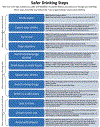Safer-use strategies in the context of harm-reduction treatment for people experiencing homelessness and alcohol use disorder
- PMID: 38905941
- PMCID: PMC11305899
- DOI: 10.1016/j.drugpo.2024.104448
Safer-use strategies in the context of harm-reduction treatment for people experiencing homelessness and alcohol use disorder
Abstract
Background: Two, randomized controlled trials found harm-reduction treatment for AUD (HaRT-A) improves alcohol outcomes for adults experiencing homelessness. HaRT-A, which neither requires nor precludes abstinence, entails tracking alcohol-related harm, harm-reduction goals, and safer-use strategies. This secondary dual study qualitatively describes this last component, safer-use strategies, and their quantitative association with treatment outcomes.
Methods: Participants were people who experienced homelessness and AUD and were enrolled in the active HaRT-A treatment arms in 2 randomized control trials (Trial 1 N = 86; Trial 2 N = 208). Trial 1was a 2-arm study with randomization to HaRT-A or services as usual. Trial 2 was a 4-arm study combining HaRT-A and extended release naltrexone. In HaRT-A sessions, participants received a list of 3 categories of safer-use strategies (i.e., buffering alcohol's effects on the body, changing the manner of drinking to be safer and healthier, and reducing alcohol use). Mixed methods were used to qualitatively describe safer-use strategies implemented and quantitatively test their association with alcohol outcomes (i.e., peak quantity, frequency, alcohol-related harm).
Results: In Trial 1, but not Trial 2, participants committed to more safer-use strategies across time, which was associated with reductions in alcohol frequency over the past 30 days. In both trials, participants committing to reducing alcohol consumption drank on a quarter fewer days overall, and in Trial 2, experienced 15 % less alcohol-related harm. In Trial 1, participants who committed to changing the manner of drinking were heavier drinkers overall, and although they showed significant reductions in alcohol-related harm, their reduction rate was slower than for participants who selected other strategies. In Trial 2, strategies to buffer alcohol's effects were associated with a monthly 14 % decrease of alcohol-related harm.
Conclusion: This study replicated prior findings that people experiencing homelessness and AUD regularly adopt strategies to reduce alcohol-related harm. The implementation of safer-use strategies was favorably associated with alcohol outcomes, but specific associations differed by trial and outcome. Discussion of safer-use strategies appears helpful; however, further research is needed to firmly establish how this HaRT-A component works.
Keywords: Alcohol use; Alcohol use disorder; Harm reduction; Homelessness; Safer-use strategies.
Copyright © 2024. Published by Elsevier B.V.
Conflict of interest statement
Declaration of competing interest Dr. Collins co-owns a business that conducts trainings and consultation on harm-reduction treatment.
Figures
Similar articles
-
Effectiveness of brief alcohol interventions in primary care populations.Cochrane Database Syst Rev. 2018 Feb 24;2(2):CD004148. doi: 10.1002/14651858.CD004148.pub4. Cochrane Database Syst Rev. 2018. PMID: 29476653 Free PMC article.
-
Managed alcohol as a harm reduction intervention for alcohol addiction in populations at high risk for substance abuse.Cochrane Database Syst Rev. 2012 Dec 12;12(12):CD006747. doi: 10.1002/14651858.CD006747.pub2. Cochrane Database Syst Rev. 2012. PMID: 23235633 Free PMC article.
-
Electronic cigarettes for smoking cessation.Cochrane Database Syst Rev. 2022 Nov 17;11(11):CD010216. doi: 10.1002/14651858.CD010216.pub7. Cochrane Database Syst Rev. 2022. Update in: Cochrane Database Syst Rev. 2024 Jan 8;1:CD010216. doi: 10.1002/14651858.CD010216.pub8. PMID: 36384212 Free PMC article. Updated.
-
Interventions to reduce harm from continued tobacco use.Cochrane Database Syst Rev. 2016 Oct 13;10(10):CD005231. doi: 10.1002/14651858.CD005231.pub3. Cochrane Database Syst Rev. 2016. PMID: 27734465 Free PMC article.
-
Baclofen for alcohol use disorder.Cochrane Database Syst Rev. 2023 Jan 13;1(1):CD012557. doi: 10.1002/14651858.CD012557.pub3. Cochrane Database Syst Rev. 2023. PMID: 36637087 Free PMC article.
Cited by
-
Primary Care Patient and Clinician Perspectives on Safer Use Strategies for Opioids and/or Stimulants: A Mixed-Method Study.J Gen Intern Med. 2025 Mar 4. doi: 10.1007/s11606-025-09418-5. Online ahead of print. J Gen Intern Med. 2025. PMID: 40038225
References
-
- Anderson K (2010). How to change your drinking: A harm reduction guide to alcohol. HAMS Harm Reduction Network.
-
- Araas TE, & Adams TB (2008). Protective behavioral strategies and negative alcohol- related consequences in college students. Journal of Drug Education, 38(3), 211–224. - PubMed
-
- Baggett TP, Chang Y, Singer DE, Porneala BC, Gaeta JM, O’Connell JJ, & Rigotti NA (2015). Tobacco-, alcohol-, and drug-attributable deaths and their contribution to mortality disparities in a cohort of homeless adults in Boston. American Journal of Public Health, 105(6), 1189–1197. 10.2105/AJPH.2014.302248 - DOI - PMC - PubMed
-
- Centers for Disease Control and Prevention [CDC]. Alcohol and public health: Alcohol-related disease impact (ARDI). Annual Average for United States 2011–2015 Alcohol-Attributable Deaths Due to Excessive Alcohol Use, All Ages. https://nccd.cdc.gov/DPH_ARDI/Default/Default.aspx.
-
- Clifasefi SL, Collins SE, Tanzer K, Burlingham B, & Larimer ME (2011). Agreement between self-report and archival public service utilization data among chronically homeless individuals with severe alcohol problems. Journal of Community Psychology, 39, 631–644. 10.1002/jcop.20457 - DOI
Publication types
MeSH terms
Substances
Grants and funding
LinkOut - more resources
Full Text Sources
Medical
Miscellaneous



